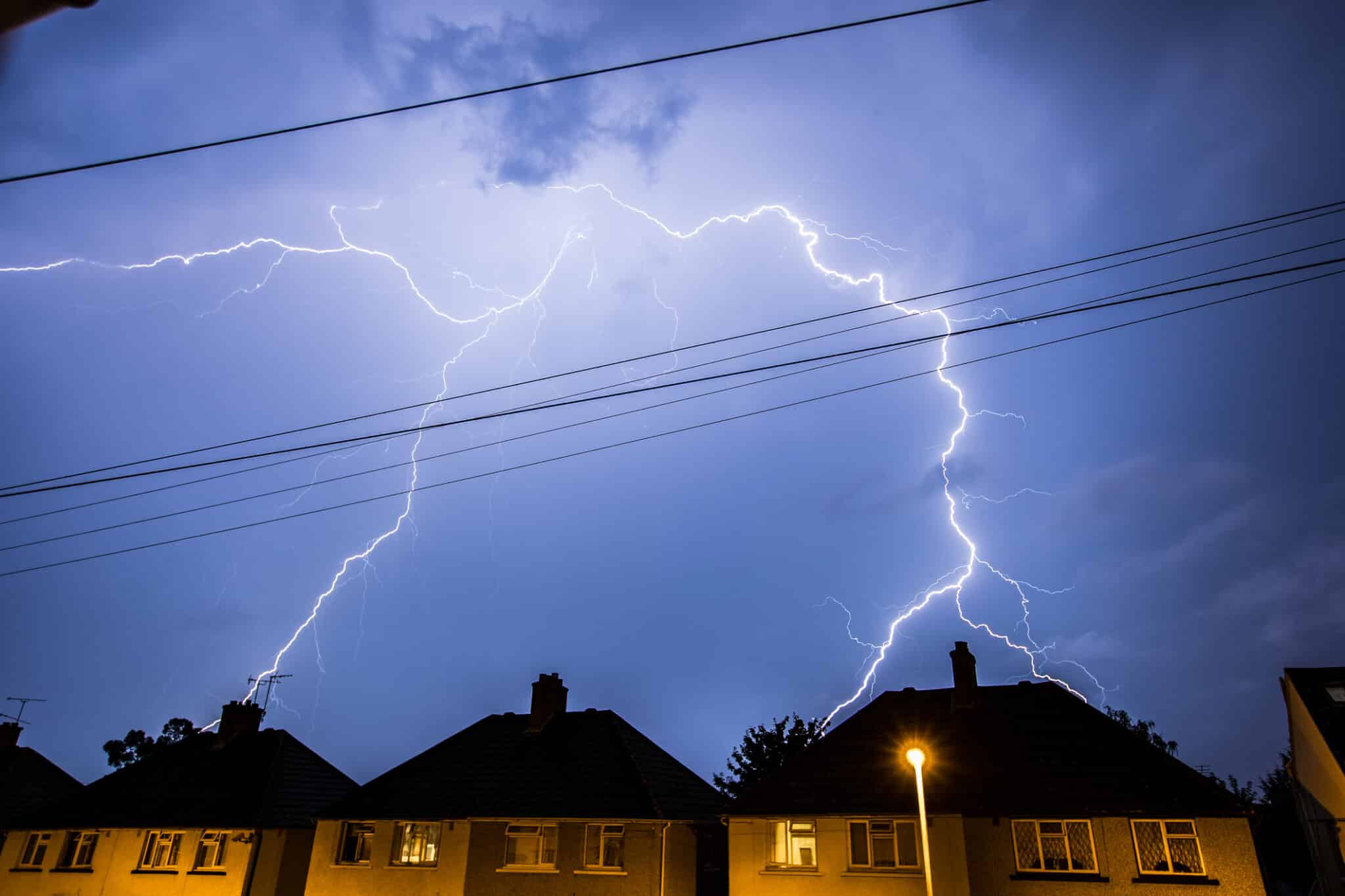Ever had your TV or computer suddenly shut down during a thunderstorm? Or noticed your lights flickering for no reason? These are often caused by power surges—quick spikes in electricity that can damage your home’s devices and even cause safety hazards.
While they may seem like small jolts, power surges can add up to big problems if they’re not managed. In this guide, we’ll walk you through what causes power surges, the risks they bring, and the easy steps you can take to protect your home and keep your electronics safe.

What Are Power Surges?
A power surge is a sudden increase in electrical voltage that flows through your home’s wiring, briefly spiking beyond the typical 120-volt level most devices are designed to handle.
This surge might last only a fraction of a second, but it can send a powerful jolt through your electronics, potentially causing damage over time. Even minor power surges can wear down delicate circuitry in everyday items like TVs, computers, and microwaves, shortening their lifespan or leading to unexpected failures.
Power surges originate from both external sources, such as lightning, and internal ones, like when high-powered appliances switch on or off. Knowing how these surges occur is essential to taking steps that protect your home and valuable electronics from unexpected damage.
Common Causes of Power Surges
Power surges can occur for various reasons, with some sources more common and damaging than others. Whether triggered by external events like storms or internal issues such as overloaded circuits, these surges can gradually or suddenly affect your home’s electrical system.
Knowing the typical causes behind power surges allows you to take preventive steps to protect your devices and appliances. With the right precautions, you can reduce the risk of unexpected repair costs and extend the lifespan of electronics around your home. Let’s take a closer look at the most common causes of power surges.
Lightning Strikes
Lightning strikes are one of the most intense and dangerous sources of power surges. When lightning strikes near your home or directly hit a power line, it sends a surge of high voltage through the connected lines, often impacting multiple homes in the area.
The resulting surge is powerful enough to damage all sorts of devices plugged into outlets, from computers to home entertainment systems.
Although lightning-related surges are less common than other types, they can lead to significant losses in an instant if the right precautions aren’t in place. Installing surge protectors or unplugging devices during storms can help prevent costly damage from these powerful surges.
Faulty Wiring
Faulty or outdated wiring is another major cause of power surges and can lead to unpredictable voltage fluctuations throughout your home. Worn-out, frayed, or improperly installed wiring may struggle to deliver a steady flow of electricity, causing frequent minor surges that add up over time.
In addition to the risk of damaged electronics, faulty wiring can increase the likelihood of electrical fires, putting both your devices and your family at risk.
Homes with older wiring, especially, are more susceptible to these issues, so regular inspections by a qualified professional can identify and address problem areas. Making sure your wiring is safe and up-to-date can greatly reduce your risk of internal power surges.
Overloaded Circuits
Overloading circuits by plugging in too many devices can lead to dangerous surges that disrupt your home’s electrical stability. High-energy appliances such as space heaters, microwaves, or air conditioners draw a lot of power, and using too many on the same circuit can overload it.
This overload puts pressure on the electrical system and increases the likelihood of surges, especially when multiple devices are drawing power at once. Rooms with multiple electronics, like kitchens or home offices, are often at higher risk for this issue, leading to unexpected power fluctuations.
Spreading out your devices across different outlets and circuits can help prevent overloaded circuits and keep your power flow consistent.
Electrical Device Malfunctions
Large appliances like air conditioners, refrigerators, and washing machines often require a surge of energy to start up, creating minor power surges within the circuit.
Each time these appliances cycle on or off, they send a small jolt through the electrical system that, while not always noticeable, can accumulate over time. Even though these surges are relatively mild, they can gradually wear down sensitive electronics like computers and TVs, especially if they’re plugged into the same circuit.
Using dedicated circuits for larger appliances can help limit the impact of these small, repetitive surges. Protecting sensitive devices with individual surge protectors is also an effective way to extend their lifespan.
How Can Power Surges Harm Your Home?
Power surges may seem like brief blips in your home’s electrical system, but their impact can be surprisingly harmful. Each surge, whether large or small, has the potential to damage electronics, appliances, and even the wiring inside your walls.
Over time, these surges add up, gradually wearing down or destroying valuable devices. Beyond the obvious inconvenience, power surges can lead to significant financial costs if appliances need to be replaced or wiring needs repairs.
Recognizing the potential harm that power surges bring helps underscore the importance of protecting your home against these voltage spikes.
Damage to Appliances
One of the most immediate effects of a power surge is damage to appliances around your home. Surges, particularly larger ones, can overwhelm the circuitry inside these devices, causing them to malfunction or fail entirely.
This can be especially costly if high-value items like refrigerators, washing machines, or ovens are damaged, as these appliances are essential to daily life and often expensive to replace.
Even minor surges can weaken appliance components over time, reducing their efficiency and lifespan. By understanding the risks power surges pose to appliances, homeowners can take preventive steps to safeguard their investments.
Shortened Lifespan of Devices
Repeated exposure to power surges, even minor ones, can wear down the internal components of your electronics and devices. Devices like computers, televisions, and gaming consoles are particularly susceptible, as their delicate circuitry can only handle so much fluctuation.
Over time, each small surge causes cumulative damage, slowly shortening the device’s lifespan. This means that, while the device may continue working for a while, it is likely to break down sooner than expected, potentially leading to unexpected replacement costs. Protecting sensitive devices with individual surge protectors is a proactive step that can help extend their usable life.
Potential Fire Hazards
Frequent voltage spikes do not just harm your devices; they can also pose serious safety risks to your home. Here’s how:
- Excessive Heat: Sudden spikes in voltage can cause your home’s wiring to overheat, especially if the wiring is old, damaged, or not built to handle high voltage. This overheating increases the risk of circuit damage and other electrical issues.
- Increased Fire Risk: The heat generated from voltage surges can lead to sparks or even full-blown fires, especially when affected wiring is hidden behind walls or ceilings. These hidden fires can be harder to detect until they’ve grown out of control.
- Outdated Wiring: Homes with older electrical systems are particularly vulnerable, as outdated wiring is less likely to withstand sudden spikes. This increases the likelihood of wiring damage and, in severe cases, can pose a significant risk to both your property and loved ones.
- Preventive Measures: Regular electrical inspections and investing in quality surge protectors can greatly reduce fire hazards, helping to keep your home’s electrical system safe and stable.
By following these preventive steps, you can enjoy greater peace of mind knowing that your home and family are well protected from the potential dangers of unexpected voltage spikes.
How to Protect Your Home from Power Surges
While power surges can be harmful, there are several effective ways to protect your home and keep your electronics safe. From individual surge protectors to whole-house solutions, these methods help control and manage excess voltage before it reaches sensitive devices.
Putting these safeguards in place minimizes the risk of damage, allowing you to feel confident that your appliances and home are protected. Let’s explore some of the best strategies for managing and preventing power surges.
Use Surge Protectors for Electronics
Surge protectors are one of the simplest and most accessible ways to protect individual electronics from power surges. These devices look like standard power strips but include built-in surge protection, which diverts excess voltage away from plugged-in devices.
Surge protectors are particularly useful for sensitive electronics, like computers, TVs, and gaming systems, which can be easily damaged by even minor surges.
When choosing a surge protector, look for one with a high joule rating, as this indicates a stronger capacity to absorb and redirect excess voltage. Installing surge protectors around your home provides a quick and effective first line of defense against power surges.
Install a Whole-House Surge Protector
A whole-house surge protector provides a more comprehensive solution by guarding your entire electrical system against surges. Installed by a professional at your home’s main electrical panel, these protectors can handle large surges, including those from lightning strikes and utility company fluctuations.
Whole-house surge protectors are especially beneficial in areas prone to storms, like Lancaster, York, and Harrisburg, PA, where homes might be more vulnerable to extreme weather events.
By blocking surges before they reach individual circuits, a whole-house surge protector provides an added layer of protection that complements individual device protectors. This investment helps ensure that all devices, large and small, are safeguarded from dangerous voltage spikes.
Unplug Devices During a Thunderstorm
Unplugging devices during thunderstorms is a straightforward, no-cost way to protect against power surges from lightning strikes. Since lightning can create powerful surges that even strong protectors may struggle to handle, unplugging high-value electronics before a storm hits can be a smart precaution.
This is especially important for items like televisions, computers, and appliances that aren’t easily replaced. While it may seem inconvenient, unplugging just a few devices when a storm is approaching is worth the peace of mind, knowing that they’re protected from potential damage. Taking a few moments to unplug devices during a storm can help prevent costly repairs or replacements later on.
Avoid Overloading Circuits
Preventing overloaded circuits is another effective way to reduce the risk of power surges inside your home. Plugging too many high-wattage appliances into one outlet or circuit increases the load and can lead to surges, especially when these devices cycle on and off.
To avoid overloading, spread out large appliances across different outlets or circuits, particularly in high-use areas like kitchens and entertainment rooms.
In addition to helping prevent surges, balancing your devices across circuits also reduces the risk of electrical overheating and improves the efficiency of your appliances. Keeping circuits balanced is a small but impactful step toward maintaining a safer and more reliable home electrical system.
Maintenance Tips to Keep Your Home Safe from Surges
Regular maintenance of your home’s electrical system is crucial to staying protected against unexpected voltage spikes. Even with surge protectors in place, proper upkeep can help ensure your devices and appliances stay safe.
By following these maintenance tips, you can reduce the risk of damage and improve the overall safety and efficiency of your home’s electrical network. Here’s how you can proactively keep your home secure.
Check Wiring Regularly
Old or damaged wiring is a common source of electrical issues, including spikes that can harm your electronics. Over time, wiring can degrade, especially in older homes, making it essential to have periodic checks by a professional.
Frayed or exposed wires can create unstable voltage flow, increasing the likelihood of internal surges and even fire hazards.
Regular inspections can help catch any issues early, allowing you to address them before they become a problem. Maintaining updated and secure wiring is one of the best ways to keep your home’s electrical system steady.
Test Surge Protectors
Surge protectors are essential tools in defending your devices, but they don’t last forever. Over time, their effectiveness can diminish, especially after they’ve absorbed multiple voltage spikes.
It is important to test or replace them periodically, as older protectors may no longer provide the level of defense your devices need. Many surge protectors come with indicator lights, signaling whether they’re still functioning.
Checking these regularly, or replacing protectors every couple of years, ensures that your electronics are consistently guarded.
Get Professional Help
When it comes to your home’s electrical system, working with a professional is always a wise choice. Electricians can help install whole-house surge protectors, update wiring, and identify any vulnerabilities in your system.
Their expertise not only ensures that all installations and repairs meet safety standards but also provides peace of mind, knowing that your home is protected by industry-grade equipment. A professional can spot risks you might not see and suggest personalized solutions to keep your home’s electrical system robust and safe.
Shield Your Home from Costly Surges – Get Expert Help Today!
Unexpected voltage spikes can wreak havoc on your appliances, shorten the lifespan of electronics, and even pose safety risks in your home. Mister Sparky of Lancaster specializes in surge protection solutions tailored for homes across Lancaster, York, and Harrisburg, PA.
Our professional electricians can assess your home’s unique needs and install top-quality surge protection to keep your electrical system safe and efficient. Do not wait until the next surge hits—contact us today to schedule your consultation and protect your home with trusted, local expertise!

Frequently Asked Questions (FAQs)
What is the difference between a surge protector and a power strip?
A power strip provides extra outlets to plug in multiple devices, making it convenient for areas with limited outlets. However, it does not protect against sudden voltage increases, which can damage electronics. A surge protector includes built-in technology to divert excess voltage away from connected devices.
How often should I replace surge protectors?
Surge protectors lose effectiveness over time as they absorb surges, so it is recommended to replace them every two to three years or after a major spike. Their protective components wear down, reducing their ability to guard against future surges.
Can voltage spikes occur without a storm?
Yes, voltage spikes aren’t limited to stormy weather; they can happen at any time. Everyday causes include high-powered appliances cycling on and off, faulty wiring, or fluctuations from your utility provider. Even without a storm, these small surges can gradually wear down electronic devices if left unprotected.
Do whole-house surge protectors stop all voltage spikes?
Whole-house surge protectors offer strong defense by blocking most large spikes from entering your home’s electrical system. However, they may not catch every minor fluctuation, especially those generated internally. Using both whole-house protectors and individual device protectors offers the most thorough protection for all electronics.
Can I install a whole-house surge protector myself?
Installing a whole-house surge protector is a job best left to a professional electrician. These protectors are connected directly to your home’s main electrical panel, which requires expertise and proper handling for safe installation. Professional installation ensures that the surge protector is set up correctly and safely to provide effective protection to your home.






